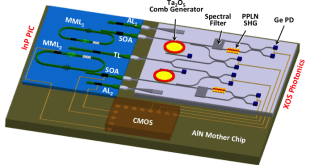The fiber optic sensors also called as optical fiber sensors use optical fiber or sensing element. These Sensors can measure a large variety of parameters, such as temperature, pressure, strain, refractive index, vibrations, displacements, bending, loading, and liquid level or concentration of chemical species. Fiber optic sensors have become a …
Read More »DARPA DODOS develops Optical frequency synthesizers (OFC) chips to enhance LIDAR, coherent communications, and chemical sensing
The need for better radar in World War II drove the development of radio frequency control, and its miniaturization in subsequent decades revolutionized a host of military and consumer applications. The generation of accurate signal frequencies from a single reference oscillator called microwave frequency synthesis, brought about many advanced technologies …
Read More »Indian Photonics technology and market growth is on the verge of explosion
Photonics is the physical science of light (photon) generation, detection, and manipulation through emission, transmission, modulation, signal processing, switching, amplification, and sensing. Though covering all light’s technical applications over the whole spectrum, most photonic applications are in the range of visible and near-infrared light. Photonic systems provide many desirable …
Read More »Terahertz technology breakthroughs enabling Next Generation Military Communications and Radars
The goal of future generation networks is to meet the future communication needs of the information societies such as Smart infrastructures, Smart City, Smart Grid, Smart Health, and Smart Transportation. The future will be a completely data-driven society in which people and things are connected universally, almost instantaneously (milliseconds) to …
Read More »Countries developing Laser Directed Energy Weapons on Aircrafts, Drones and Satellites to shoot down enemy’s aircrafts, missiles, and satellites
Laser weapons use high power lasers to damage or destroy adversary equipment, facilities, and personnel. The technology provides major advantages for military applications due to High precision and rapid on-target effect, precise and scalable effects, Avoidance of collateral damage caused by fragmenting ammunition, Low logistics overhead and minimum costs per …
Read More »Helicopter Pilots require Digital Night Vision Tech for Night Operations
Pilots rely more on vision than on any other sense to orient themselves in flight. The visual sense is especially important in collision avoidance and depth perception. A pilot’s vision sensors are the eyes generally are most accurate and reliable sense, even though they are not perfect in the way …
Read More »Li-Fi Technology promise to bring the Internet ot IoT Under the Sea and improve Navy’s Ship and submarine communications
It is predicted that LEDs will be the ultimate light source in the near future powering indoor illumination, outdoor lamps, traffic signs, advertising displays, car headlights/taillights, etc. Now another technique promises to double the utility of light-emitting diodes (LEDs) by using their light as a medium for communication in a …
Read More »Researchers realizing challenging goal of integrating lasers on silicon photonics
The wide adoption of smartphones, high-definition content streamed on social media, the Internet of Things, data saved to the cloud, and artificial intelligence used in massive data analytics have ushered in the current era of digital economies and Industry 4.0. These applications demand high-bandwidth optical networks and digital infrastructures capable …
Read More »DARPA developing anti-laser defences for US aircraft pilots and Wearable Laser Detection and Alert System
In recent years, high power fiber and semiconductor laser technology has improved rapidly, with power density increasing by an order of magnitude or more. Much of this increase has been driven by demand for industrial cutting machines and high-bandwidth, long-range telecommunications. These same laser materials and devices can also be …
Read More »DARPA’s PULSE developed ultrafast Laser technology to improve range and resolution of next generation military navigation, communication, imaging and radar systems
The ability to observe events on such timescales is important for basic physics — to understand how atoms move within molecules — as well as for engineering semiconductor devices, and for understanding basic biological processes at the molecular level. Today, researchers can easily reach into the realm of femtoseconds — quadrillionths …
Read More » International Defense Security & Technology Your trusted Source for News, Research and Analysis
International Defense Security & Technology Your trusted Source for News, Research and Analysis








